灌淤冻土复合衬砌渠道保温防冻胀效果分析
2021-01-14张栋,郭璇,2
张 栋,郭 璇,2
灌淤冻土复合衬砌渠道保温防冻胀效果分析
张 栋1,郭 璇1,2※
(1. 北京交通大学土木建筑工程学院,北京 100044;2. 北京交通大学城市地下工程教育部重点实验室,北京 100044)
为解决河套灌区渠道混凝土衬砌冻胀破坏问题,该研究提出由聚氨酯和聚苯乙烯2种材料组成的复合衬砌结构,建立渠道基土水热力耦合数值模型,通过现场试验和数值模拟方法分析不同衬砌结构下基土地温、含水率、冻胀量及等效应力变化。结果表明:与无保温衬砌结构相比,阴坡聚苯乙烯复合衬砌结构和聚氨酯复合衬砌结构下基土最低地温分别提高67.1%和64.7%,最大迁移含水率分别减少8%和9%,最大冻胀量分别减少80%和81%,基土内等效应力明显减小。这2种复合衬砌结构具有保温效果好、冻胀变形小等优点,可作为寒区渠道保温防冻胀衬砌结构的选择。同时数值模型计算结果与试验值基本吻合,说明此数值模型可合理地描述渠道基土冻结过程中地温和冻胀量变化。研究可为寒区渠道防冻胀衬砌结构设计提供理论依据和参考。
冻土;渠道;衬砌结构;保温;防冻胀;水热力耦合模型
0 引 言
中国是世界上第三大冻土国家,季节性冻土占国土面积的53.5%,中国约有98.9%的面积被不同类型的冻土所覆盖[1]。一些寒区的工程建设经常遭受冻害而破坏,比如中国东北和西北地区的许多农业灌溉渠道经常受气候季节性变化发生冻胀融沉,失去渠道防渗输水功能,为此渠道管理部门每年都要维修破坏的渠道,这造成大量人力与物力浪费,研究寒区渠道保温防冻胀衬砌结构是十分必要和迫切。
前人在渠道衬砌工程防冻胀方面有大量研究。王正中等[2]为了探明刚性衬砌渠道设置不同纵缝削减冻胀的机理及量化影响规律,利用有限元软件对渠道坡脚处、1/3坡高处、宽底板的中心处分别设纵缝和不设纵缝的刚性衬砌渠道冻胀过程进行数值模拟。程满金等[3]通过对聚苯乙烯保温板在渠道衬砌防冻胀中的应用研究,分析了渠道不同坡面冻胀规律,总结聚苯乙烯保温防冻胀效果,并将研究成果在河套灌区中推广应用。安鹏等[4]以聚苯乙烯泡沫板为例提出了部分保温法,分析了其合理性和适用条件之后,基于热阻等效原理给出厚度计算方法与数值模拟。Li等[5]基于二维水热耦合模型,分析了季冻区宁夏灌区不同衬砌结构防冻胀效果。郭富强等[6]通过建立不同地下水位冻胀试验平台并结合原型渠道,分析了不同地下水位对铺设不同厚度聚苯板的基土冻胀的影响,提出了不同地下水位下聚苯板适宜铺设厚度的理论计算公式。郭瑞等[7]依据固体材料接触热阻原理与压力相关的传热本构模型,提出了混凝土复合保温衬砌新型式。Taylor等[8-10]学者建立了第一个冻土内水热耦合模型,并分析了正冻土中水热变化。赖远明等[11]运用传热学、冻土物理学和冻土流变学的基本理论、考虑水分场和温度场的相互作用、以及温度变化对渠道土体力学性质的影响,同时引入冻土蠕变方程,建立了寒区水渠的热力分析模型,并对水渠的热力学状况进行了分析。李智明[12]基于饱和冻土水热力场耦合模型,采用有限元分析软件对大庆市北部引嫩工程渠道温度场、水分场、应力场进行数值模拟分析。Li等[13-14]建立冻土水热力数值模型,开发计算程序研究寒区渠道冻胀机理。Bai等[15]进行非饱和冻土单向冻结试验,研究了非饱和冻土中相变及变形,提出了非饱和土的热-水-力-气耦合力学模型。Guo等[16-17]发展了热力学理论新框架和双面损伤本构模型等。综上所述,前人在渠道保温防冻胀机理和冻土多场耦合理论方面取得许多研究成果,尤其是对渠道传统保温材料聚苯乙烯进行了大量试验和理论研究,冻土多场耦合理论也逐渐完善,从最初饱和冻土水热耦合向水热力耦合过渡,目前对非饱和冻土四相耦合也进行了研究。随着新材料出现,渠道防冻胀衬砌结构型式也多样化,但聚氨酯保温材料在渠道中的应用还比较少。基于前人研究成果,本文同时开展聚氨酯和聚苯乙烯2种材料保温防冻胀试验与水热力耦合数值研究,以补充聚氨酯材料在渠道防冻胀中的应用理论。
本文针对内蒙古河套灌区渠道衬砌冻胀破坏问题,提出由聚氨酯和聚苯乙烯两种材料组成的复合衬砌结构,并建立渠道基土水热力多场耦合模型,通过现场试验和数值模拟分析2种复合衬砌结构下基土内地温、含水量、冻胀量及等效应力的变化分析其保温防冻胀效果。
1 试 验
试验地位于内蒙古河套灌区临河南边分干渠,107°6′E,40°31′N,属于季节性冻土地区,渠基土为易冻胀性粉土,年平均气温6.9 ℃,渠道基土初始含水率为25%,冻融期持续5.5个月,每年11月中旬开始冻结,至次年5月融通,持续160 d左右,冻深在70~140 cm之间。渠道是南北走向,由于太阳辐射时间不同,渠道边坡分为阴、阳坡,图 1a为试验原型渠道[18]。复合衬砌结构是一种由6 cm厚混凝土砌块、2 cm厚砂浆、聚乙烯薄膜、聚苯乙烯保温板或聚氨酯保温板共同组成的有效防冻胀衬砌结构,现场渠道边坡衬砌结构如图1b所示。只在渠道边坡铺设复合衬砌结构,渠底和渠顶无保温材料,原型渠道剖面如图2所示,图中保温板是指聚氨酯保温板和聚苯乙烯保温板。混凝土板具有低渗和高强度特性,砂浆砌筑混凝土砌块,聚乙烯薄膜是隔水层,聚苯乙烯板和聚氨酯板具有导热系数小、密度低特点。根据工程经验[18],为了研究不同保温材料复合衬砌结构的保温防冻胀效果,本文选择现场渠道工程铺设的厚度方案作为试验研究,将试验分为3种工况,如表1所示,工况1为无保温材料的传统衬砌结构,工况2为聚苯乙烯保温材料复合衬砌结构,工况3为聚氨酯保温材料复合衬砌结构。阴阳坡由于太阳光辐射不同,需要铺设不同厚度保温板。每一种工况下地温传感器(PT100)T1~T6分别布置在阳坡中部法向16、30、50、75、100、120 cm深度处,T7~T12分别布置在阴坡中部法向16、30、50、75、100、120 cm深度处,如图2所示,通过地温信号巡检仪接收数据端口和无线设备实现地温的采集、无线传输、存储。烘干法测量了边坡不同深度处土壤在冻结前、冻结后的基土含水率,位移传感器(WDL)D1和D2分别测量阳坡、阴坡中部衬砌表面法向冻胀量。本文试验数据监测周期是2015年11月1日至2016年4月30日。
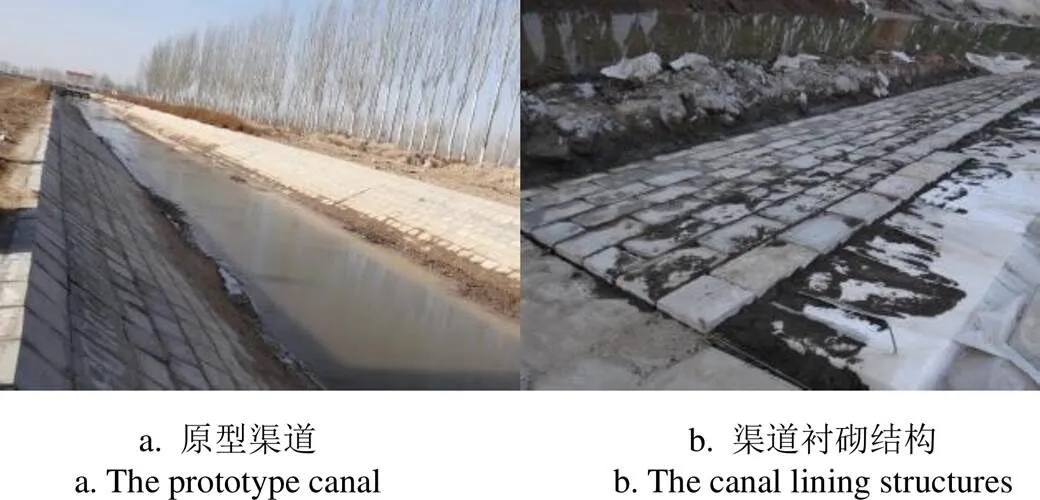
图1 原型渠道及衬砌结构

注:T1~T12为温度传感器,D1~D2为位移传感器。

表1 试验工况
2 数值模型和控制方程
渠道走向认为是很长的柱形体,截面沿长度方向不变,冻胀破坏发生在二维截面内,属于平面应变问题,所以本节在平面坐标下建立渠道基土二维冻胀数值模型。
2.1 水热耦合模型
地温主要通过热传导进行传递[8,19],水分迁移和冰水相变对温度场有显著影响,必须在传热方程中加以考虑,其表达式为


冻土中水分迁移方程为[8]


式中1和1是试验常数。
把式(2)代入式(1),得正冻土中水热耦合方程

2.2 本构模型
外荷载作用下,冻土的应力应变关系可由下面增量形式给出[21-24]


由于假定了冻土和未冻土均为各向同性介质,因此体积冻胀变形在各个方向是相等的[11,21,23],即


根据Prandtl-Reuss准则,冻土蠕变应变增量向量可以表示成[11]


在复杂应力状态下,其蠕变规律可由单轴条件下的蠕变方程推广而来,即

从式(9)和式(11)可得到复杂应力状态下的时间硬化蠕变方程

土体的应变和位移之间的关系可写为

方程(1)~(13)组成冻土水热力耦合数值模型,这是一个高度非线性问题,只能通过数值有限元求解。
3 渠道复合衬砌有限元分析
渠道冻胀破坏是由于在负温下衬砌下面基土发生不均匀冻胀所致,本文主要分析对象是渠道基土,为了简化建模和节约计算成本将衬砌混凝土砌块当作整体来建模,在原型渠道基础上得到有限元模型,为了消除边界的影响,边界至少取3~5倍的冻结深度,从渠底向下取500 cm为底部边界,从衬砌边缘向左右两边分别取500 cm为左右边界,用有限元软件COMSOL Multiphysics建立渠道模型并进行分析计算,渠道计算剖面有限元网格划分模型如图3所示。渠道衬砌材料热力学参数列于表2[18]。由于冻土弹性模量()和冻胀率()受温度()影响,表3为冻土弹性模量和冻胀率[18,25]。
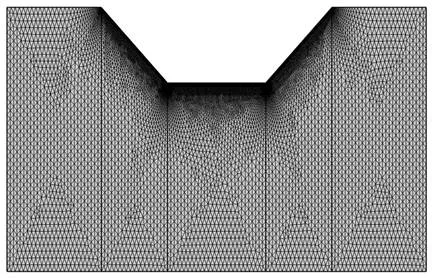
图3 渠道有限元网格划分模型
冻土中孔隙冰会阻碍水分迁移,因此冻土中水力传导性和扩散系数比未冻土中要小,引入阻尼系数描述这种现象[28]

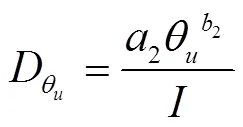

式中2,2,3,3是试验常数,如表4中所示[14,29]。

表2 渠道衬砌材料热力学参数

表3 冻土弹性模量及冻胀率
考虑温度对冻融土中冰和未冻水有直接影响,许多研究表明冻土力学参数可用下面公式近似表示[11,13-14,30-32]



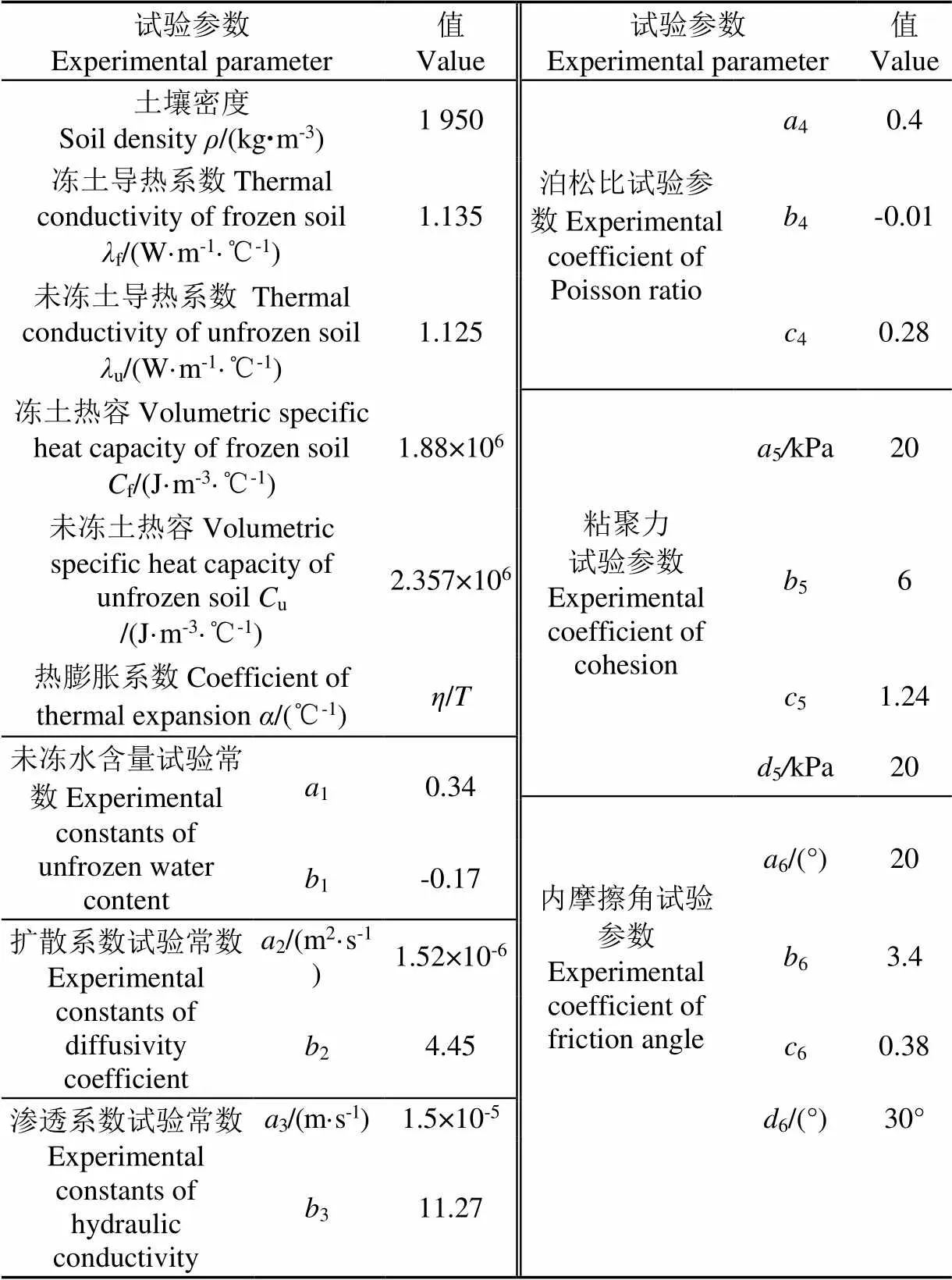
表4 渠基土试验参数
通过对河套灌区渠道地区气候数据的长期观察,用回归分析法获得了渠道不同表面温度变化方程[11,18,33]。原型渠道地表AB和EF边(图2)施加下面温度边界

原型渠道阳坡BC边施加下面温度边界

原型渠道阴坡DE边施加下面温度边界

原型渠道渠底CD边施加下面温度边界

两侧边界AH和FG边为绝热条件,底部边界GH施加地热流=0.03W/m2。
土体初始含水量为0.25;根据相关研究成果[11],基土的蠕变参数见下表5。由于渠道地下水位较高,在冻结过程中地下水可源源不断补充到冻结峰面上,因此在模拟中将其视为开放体系,同时忽略降水及两侧水分的补给。在力学计算中,只约束两侧边界AH和FG边的水平位移,底部GH为固定边界,其余为自由边界。
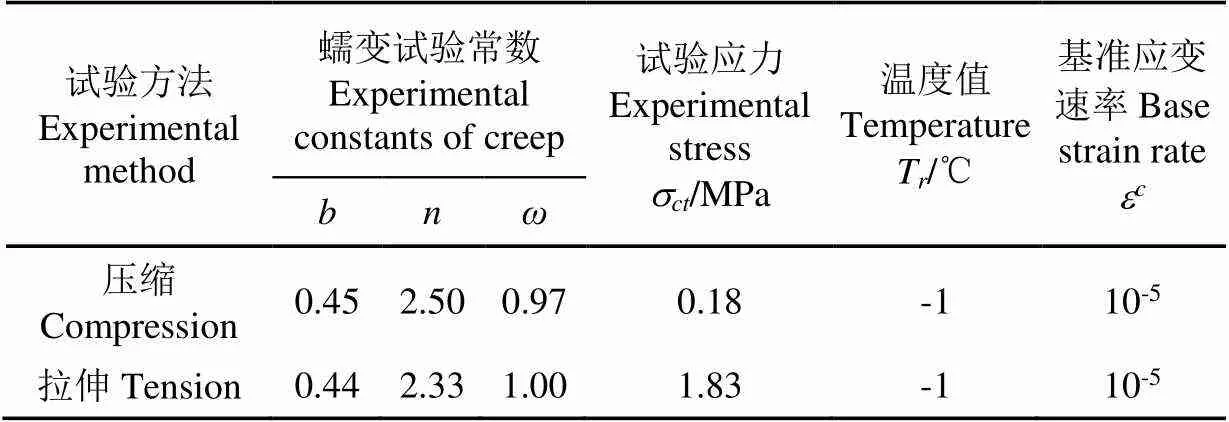
表5 基土蠕变参数
每年气温季节性变化引起地温周期变化,根据河套灌区气温数据资料分析[18],每年最低地温在1月上旬,最大冻深在2月中旬,所以主要分析保温防冻胀衬砌结构下基土最低地温(2016年1月10日),最大冻深时(2016年2月15日),冻结前(2015年11月30日)和冻结后(2016年2月17日)基土含水量及最大冻胀量(2016年2月15日)的变化。
4 结果分析
4.1 不同工况下边坡基土地温分析
图4为渠道衬砌施工完第1年后各工况下边坡基土最低地温模拟分布图。从图中可以看出:工况2和工况3下基土地温分布明显高于工况1地温,同一工况下阴坡地温低于阳坡地温,这与实测数据规律一致。此外各工况下渠底、坡角和坡顶一定范围处地温比边坡地温低,这是由于渠底和渠顶处没有铺设保温衬砌结构层,导致局部地温低。
图5为各工况下边坡不同深度处地温试验值与模拟值分布。从图中可以看出地温沿着边坡法向深度增加而升高,同一深度处工况2和工况3处的地温值高于工况1处地温值,这种现象在阴坡尤其明显,例如工况1阴坡和阳坡法向16 cm深度处地温分别为-8.5和-2 ℃,工况 2同位置处地温分别为-2.8和-1.5 ℃,工况3同位置处地温分别为-3.0和-1.4 ℃,工况2和工况3阴坡地温分别提高67.1%和64.7%,说明工况2和工况3下衬砌结构起到了良好的保温功能。同时地温模拟值与试验值基本一致,最大绝对差值仅为0.4 ℃,说明此数值模型可以较精确地模拟渠道基土地温。

图4 各工况混凝土衬砌下基土最低地温分布

图5 不同工况下基土地温沿边坡法向深度分布
4.2 冻深和冻胀量分析
图6a为各工况下边坡法向最大冻深试验值与模拟值比较。从图中得出工况1冻深值远大于工况2和工况3的冻深值,阴坡工况1最大冻深试验值为138 cm,而工况2和3分别为40.0 cm和34.0 cm,最大冻深分别减小71%和75%,说明工况2和工况3的复合衬砌结构有效地提高地温,减小冻深。最大冻深模拟值与试验值基本吻合,最大误差仅为3.2%。
图6b为各工况冻结期边坡法向最大冻胀量的试验值和模拟值。从图中看出工况1法向最大冻胀量值远大于工况2和工况3下的最大冻胀量值,例如工况1阴坡和阳坡法向最大冻胀量试验值分别为14和4.7 cm,工况2同位置处分别为2.8 和2.1 cm,工况3同位置处分别为2.6和1.5 cm,工况2和工况3阴坡最大冻胀量分别减少80%和81%,这说明工况2和工况3的复合衬砌结构有效地减小最大冻胀量值。同时最大冻胀量模拟值与测量值基本一致,最大误差为9.5%,说明此模型可较好地描述冻胀量。
4.3 含水量分析
图7为各工况冻结前后含水量沿边坡法向深度的分布。从图中可以看出:阳坡法向80 cm深度范围内冻结后含水率大于冻结前含水率,阴坡法向100 cm深度范围内冻结后含水率大于冻结前含水率,这说明冻结前后土壤内发生水分迁移,深部土壤水分在冻结温度梯度下向浅部基土迁移。工况1冻结前后浅部基土迁移水分最多,阴坡和阳坡法向20 cm深度处最大迁移含水量分别约为13%和4%,工况2同位置最大迁移含水量分别为5%和2%,工况3同位置最大迁移含水量分别为4%和1.1%。与工况1比较,工况2和工况3阴坡最大迁移含水率分别减少8%和9%,这是因为工况2和工况3在保温衬砌结构下基土地温变化小,迁移水分少。
4.4 应力分析
图8为各工况下最大Mises等效应力分布图。从图中得出工况1渠道边坡基土等效应力明显大于工况2和工况3边坡基土等效应力,这是由于工况1基土地温变化大,导致基土冻胀应变和应力大。同时在坡脚和坡顶拐点处会产生应力集中,比如工况1阴坡渠顶拐点处等效应力达到299 kPa,远大于冻土强度,极易发生冻胀破坏,因此后续渠道设计中应在渠底和渠顶也铺设保温板,以减小这些拐点处温差变化。
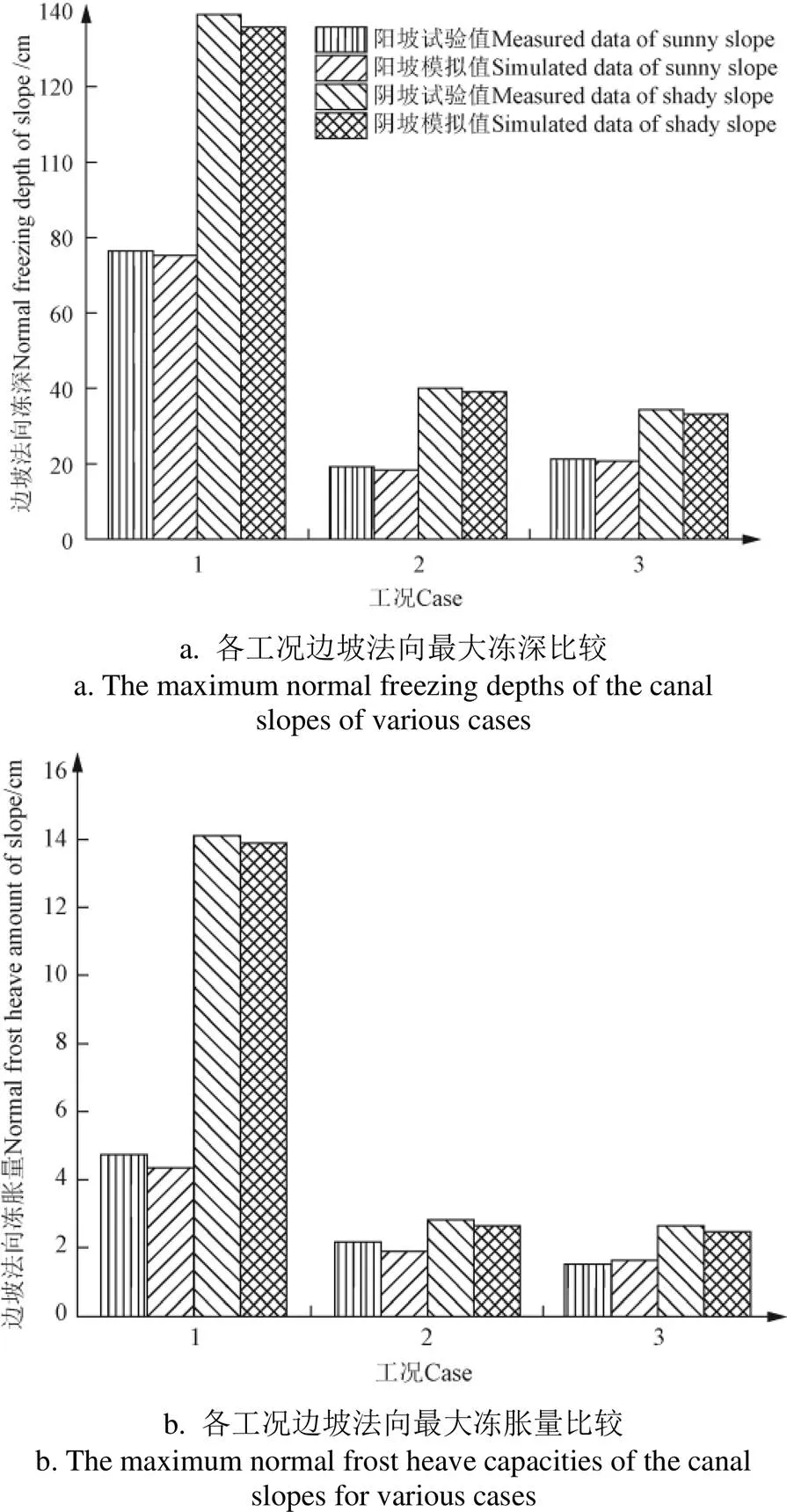
图6 各工况边坡法向最大冻深和冻胀量
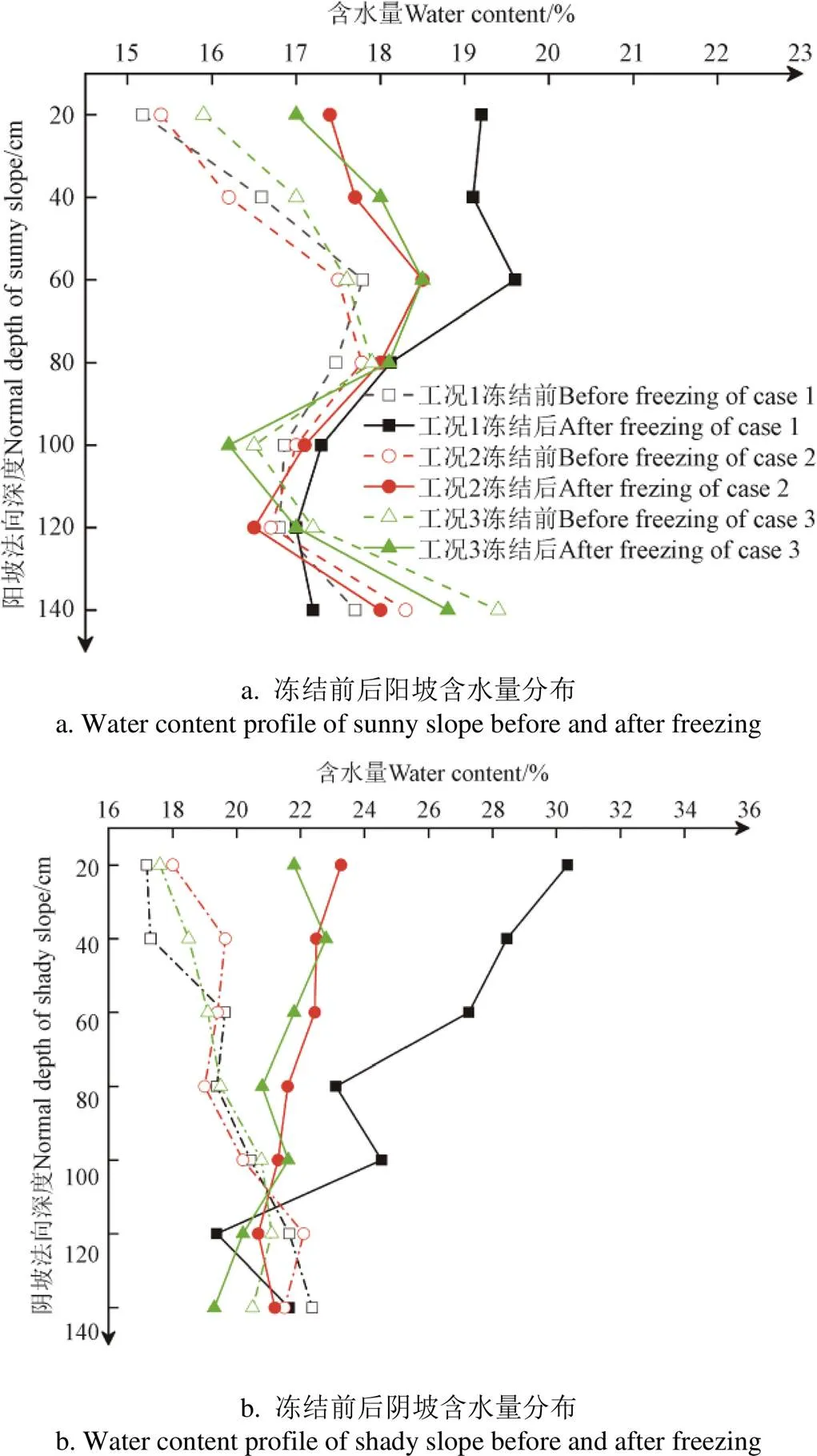
图7 冻结前后含水量沿边坡法向深度分布

图8 不同工况下最大Mises等效应力分布
5 结 论
针对寒区渠道衬砌结构冻胀破坏问题,提出由聚苯乙烯和聚氨酯组成的两种保温防冻胀衬砌结构,建立渠道基土二维水热力耦合数值模型,使用现场试验和数值模拟方法对渠道不同衬砌结构的保温效果进行分析。综上所述,得出以下结论:
1)与无保温衬砌结构相比,聚苯乙烯和聚氨酯两种保温衬砌结构下阴坡最小地温分别提高67.1%和64.7%、最大冻深分别减小71%和75%、最大迁移含水率分别减少8%和9%、最大冻胀量分别减少80%和81%,两种复合衬砌结构具有较好的保温防冻胀效果,可作为寒区渠道防冻胀衬砌结构的选择。
2)应用已有经典冻土水热力耦合模型计算的结果与现场实测值吻合较好,地温模拟值与试验值最大绝对差值仅为0.4 ℃,最大冻深模拟值与试验值最大误差仅为3.2%,最大冻胀量模拟值与试验值最大误差为9.5%,这可为寒区渠道的保温衬砌结构设计提供参考,利用该模型还可以准确描述渠道基土冻结过程中地温和冻胀量的变化。
3)根据现场试验资料,发现无保温衬砌结构渠道下地温分布受冬季气温的影响较大,阴坡最大冻深约为138 cm,浅部基土最大迁移含水量达到13%;阳坡最大冻深约为75 cm,浅部基土最大迁移含水量约为4%,迁移含水量造成的冻胀是衬砌破坏的主要因素。
4)数值计算结果表明只在渠道边坡铺设保温衬砌结构后,渠底和渠顶局部范围内会出现地温变化大、应力集中现象,因此寒区渠道应在渠顶和渠底铺设保温衬砌结构,以保护渠道整体结构的稳定性。
[1] 徐学祖,王家澄,张立新. 冻土物理学[M]. 北京:科学出版社,2001.
[2] 王正中,刘旭东,陈立杰,等. 刚性衬砌渠道不同纵缝削减冻胀效果的数值模拟[J]. 农业工程学报,2009,25(11):1-7. Wang Zhengzhong, Liu Xudong, Chen Lijie, et al. Computer simulation of frost heave for concrete lining canal with different longitudinal joints[J]. Transactions of the Chinese Society of Agricultural Engineering (Transactions of the CSAE), 2009, 25(11): 1-7. (in Chinese with English abstract)
[3] 程满金,申利刚,步丰湖,等. 聚苯乙烯保温板在衬砌渠道防冻胀中的应用研究[J]. 灌溉排水学报,2011,30(5):22-27. Cheng Manjin, Shen Ligang, Bu Fenghu, et al. Application of polystyrene insulation board used for anti-frost in lining channel[J]. Journal of Irrigation and Drainage, 2011, 30(5): 22-27. (in Chinese with English abstract)
[4] 安鹏,邢义川,张爱军. 基于部分保温法的渠道保温板厚度计算与数值模拟[J]. 农业工程学报,2013,29(17):54-62. An Peng, Xing Yichuan, Zhang Aijun. Thickness calculation and numerical simulation of insulation board for canal using partial insulation method[J]. Transactions of the Chinese Society of Agricultural Engineering (Transactions of the CSAE), 2013, 29(17): 54-62. (in Chinese with English abstract)
[5] Li Zhuo, Liu Sihong, Feng Youting, et al. Numerical study on the effect of frost heave prevention with different canal lining structures in seasonally frozen ground regions[J]. Cold Regions Science and Technology, 2013, 85: 242-249.
[6] 郭富强,史海滨,程满金,等. 不同地下水位下渠基冻胀规律与保温板适宜厚度确定[J]. 农业工程学报,2018,34(19):95-103. Guo Fuqiang, Shi Haibin, Cheng Manjin, et al. Law of frost heave of canal foundation and appropriate thickness of insulation board under different groundwater levels[J]. Transactions of the Chinese Society of Agricultural Engineering (Transactions of the CSAE), 2018, 34(19): 95-103. (in Chinese with English abstract)
[7] 郭瑞,王正中,牛永红,等. 基于TCR传热原理的混凝土复合保温衬砌渠道防冻胀效果研究[J]. 农业工程学报,2015,31(20):101-106. Guo Rui, Wang Zhengzhong, Niu Yonghong, et al. Anti-frost heave effect of lining channel with concrete composite insulation based on TCR principle[J]. Transactions of the Chinese Society of Agricultural Engineering (Transactions of the CSAE), 2015, 31(20): 101-106. (in Chinese with English abstract)
[8] Harlan R L. Analysis of coupled heat‐fluid transport in partially frozen soil[J]. Water Resources Research, 1973, 9(5): 1314-1323.
[9] Guymon G L, Luthin J N. A coupled heat and moisture transport model for Arctic soils[J]. Water Resources Research, 1974, 10(5): 995-1001.
[10] Taylor George S, Luthin James N. A model for coupled heat and moisture transfer during soil freezing[J]. Revue Canadienne De Géotechnique, 1978, 15(4): 548-555.
[11] 赖远明,张明义,李双洋. 寒区工程理论与应用[M]. 北京:科学出版社,2009.
[12] 李智明. 冻土水热力场耦合机理研究与工程应用[D]. 哈尔滨:哈尔滨工业大学,2017. Li Zhiming. Study on Mechanisum of Moisture-heat-stress Coupling for Frozen Soil and Engineering Application[D]. Harbin: Harbin Institute of Technology, 2017. (in Chinese with English abstract)
[13] Li Shuangyang, Zhang Mingyi, Tian Yibin, et al. Experimental and numerical investigations on frost damage mechanism of a canal in cold regions[J]. Cold Regions Science and Technology, 2015, 116: 1-11.
[14] Li Shuangyang, Lai Yuanming , Pei Wansheng, et al. Moisture–temperature changes and freeze–thaw hazards on a canal in seasonally frozen regions[J]. Natural Hazards, 2014, 72(2): 287-308.
[15] Bai Ruiqiang, Lai Yuanming, Zhang Mingyi, et al. Study on the coupled heat-water-vapor-mechanics process of unsaturated soils[J]. Journal of Hydrology, 2020, 585: 1-12.
[16] Guo Xuan, Zhao Chenggang, Yuan Dajun, et al. A thermomechanical damage approach to constitutive models for rate-independent dissipative geomaterials[J]. Acta Mechanica Solida Sinica, 2008,21(1):73-84.
[17] Guo Xuan, Zhao Chenggang, Yuan Dajun, et al. A dual-surface damage model and evaluation for natural soils within the thermomechanical framework[J]. Acta Mechanica Solida Sinica, 2008,21(1):85-94.
[18] 张栋. 渠道衬砌工程保温防冻胀试验研究[D]. 包头:内蒙古科技大学,2016. Zhang Dong. Insulation Anti-freezing Test Research on the Canal Lining Engineering[D]. Baotou: Inner Mongolia University of Science and Technology, 2016. (in Chinese with English abstract)
[19] Jame Yih Wu, Norum Donald I. Heat and mass transfer in a freezing unsaturated porous medium[J]. Water Resources Research, 1980, 16(4): 811-819.
[20] Selvadurai A P S, Hu J, Konuk I. Computational modelling of frost heave induced soil–pipeline interaction: I. Modelling of frost heave[J]. Cold Regions Science and Technology, 1999, 29(3): 215-228.
[21] Lai Yuanming, Zhang Xuefu, Xiao Jianzhang, et al. Nonlinear analysis for frost-heaving force of land bridges on Qing-Tibet railway in cold regions[J]. Journal of Thermal Stresses, 2005, 28(3): 317-331.
[22] Liu Zhen, Yu Xiong. Coupled thermo-hydro-mechanical model for porous materials under frost action: Theory and implementation[J]. Acta Geotechnica, 2011, 6(2): 51-65.
[23] Shen Mu, Branko Ladanyi. Modelling of coupled heat, moisture and stress field in freezing soil[J]. Cold Regions Science & Technology, 1987, 14(3): 237-246.
[24] Thomas H R, Cleall P, Li Y C, et al. Modelling of cryogenic processes in permafrost and seasonally frozen soils[J]. Géotechnique, 2009, 59(3): 173-184.
[25] 李甲林. 渠道衬砌冻胀破坏力学模型及防冻胀结构研究[D]. 杨凌:西北农林科技大学,2009. Li Jialin. Mechanicals Models of Frost-heaving and the Research of Anti-frost Heave Structure for Lining Canal[D]. Yangling: Northwest Agricultural and Forestry University, 2009. (in Chinese with English abstract)
[26] 王正中,沙际德,蒋允静,等.正交各向异性冻土与建筑物相互作用的非线性有限元分析[J].土木工程学报,1999(3):3-5. Wang Zhengzhong, Sha Jide, Jiang Yunjing, et al. Nonlinear finite element analysis of interaction of orthotropic frozen ground and construction[J]. China Civil Engineering Journal 1999(3): 3-5. (in Chinese with English abstract)
[27] 李爽,王正中,高兰兰,等.考虑混凝土衬砌板与冻土接触非线性的渠道冻胀数值模拟[J]. 水利学报,2014,45(4):497-503. Li Shuang, Wang Zhengzhong, Gao Lanlan, et al. Numerical simulation of canal frost heaving considering nonlinear contact between concrete lining board and soil[J]. Journal of Hydraulic Engineering, 2014, 45(4): 497-503. (in Chinese with English abstract)
[28] Wilson G. P. Newman G. Heat and mass transfer in unsaturated soils during freezing[J]. Can. Geotech. J, 1997, 34(1): 63-70.
[29] Li Shuangyang, Lai Yuanming, Zhang Mingyi, et al. Seasonal differences in seismic responses of embankment on a sloping ground in permafrost regions[J]. Soil Dynamics and Earthquake Engineering, 2015, 76: 122-135.
[30] Li Shuangyang, Zhang Mingyi , Pei Wansheng, et al. Experimental and numerical simulations on heat-water-mechanics interaction mechanism in a freezing soil[J]. Applied Thermal Engineering, 2018, 132: 209-220.
[31] Zhang Shujuan, Sun Zhizhong, Xu Xiangtian, et al. Volumetric calculation method and temperature characteristics of frozen soil in mechanical testing[J]. Cold Regions Science & Technology, 2013, 85: 225-231.
[32] 吴紫汪,马巍. 冻土强度与蠕变[M].兰州:兰州大学出版社,1994.
[33] 郭富强. 北方季节性冻土区渠道保温防冻胀机理与应用研究[D].呼和浩特:内蒙古农业大学,2019. Guo Fuqiang. Mechanism and Application Research of Heat Preservation and Frost Heaving of Canal in the Area of Seasonal Frozen Soil in the North[D]. Hohhot: Inner Mongolia Agricultural University, 2019. (in Chinese with English abstract)
Effects of thermal insulation and anti-frost heaving in composite lining structures for a canal in colmatage frozen soil
Zhang Dong1, Guo Xuan1,2※
(1.,,100044,;2,,100044,)
This study aims to explore the frost heaving failure of concrete lining in a canal in the Hetao Irrigation Area. Two composite lining structures were proposed, including polyurethane and polystyrene. A coupled heat-moisture-stress model was established for the channel soil. In-situ test and numerical simulation were combined to analyze the variation in soil temperature, moisture content, frost-heave capacity, and equivalent stress in different lining structures. The results showed that: The ground temperatures were -8.5 ℃ and -2 ℃ at the normal depth of 16 cm on the shady slope and sunny slope of non-thermal insulation lining structure; those were -2.8 ℃ and -1.5 ℃ at the same positions for the polystyrene composite lining structure; those were -3.0 ℃ and -1.4 ℃ for the polyurethane composite lining structure. The maximum water contents were approximately 13% and 4% at the normal depth of 20 cm on the shady slope and the sunny slope of non-thermal insulation lining structure before and after freezing; those were 5% and 2% at the same location for the polystyrene composite lining structure; those were roughly 4% and 1.1% for the polyurethane composite lining structure. The measured maximum normal capacity of frost heave were 14 cm and 4.7 cm on the shady slope and the sunny slope in the non-thermal insulation lining structure; those were 2.8 cm and 2.1 cm for the polystyrene composite lining structure; and those were 2.6 cm and 1.5 cm for the polyurethane composite lining structure. It infers that the maximum normal capacities of frost heave for the non-thermal insulation lining structure were far greater than those of the polystyrene and the polyurethane composite lining structure. The maximum normal capacities of frost heave were reduced by 80% and 81% on the shady slopes for the polystyrene and the polyurethane composite lining structure. The equivalent stress of channel soil for the non-thermal insulation lining structure was significantly greater than those of polystyrene and the polyurethane composite lining structure. This change can be attributed to the large difference in soil temperature for the non-thermal insulation lining structure, which can result in a large strain and stress of frost heaving in the canal soil. The stress concentration occurred at the inflection points of the top and bottom of a canal. The simulated values in numerical models were basically consistent with the experimental values, indicating that the mathematical model can be suitable to describe the changes of ground temperature and frost-heave capacity during the freezing process of channel soil. Two kinds of thermal insulation lining structures demonstrated the low permeability, low heat transfer, good function of heat preservation, and small deformation of frost heave. They can be excellent choices for seepage prevention and anti-frost heave of canal in seasonal frozen soil areas. The finding can be helpful to understand the frost heaving mechanism of channel soil, and further to provide a sound reference for the design and maintenance of channels in cold regions.
frozen soil; canal;lining structure; thermal insulation; anti-frost heaving; heat-moisture-stress coupled model
张栋,郭璇. 灌淤冻土复合衬砌渠道保温防冻胀效果分析[J]. 农业工程学报,2020,36(21):122-129. doi:10.11975/j.issn.1002-6819.2020.21.015 http://www.tcsae.org
Zhang Dong, Guo Xuan. Effects of thermal insulation and anti-frost heaving in composite lining structures for a canal in colmatage frozen soil[J]. Transactions of the Chinese Society of Agricultural Engineering (Transactions of the CSAE), 2020, 36(21): 122-129. (in Chinese with English abstract) doi:10.11975/j.issn.1002-6819.2020.21.015 http://www.tcsae.org
2020-08-05
2020-10-20
国家自然科学基金(51678038);霍英东教育基金(122009);中国国家留学基金委(201707095041);中央高校基本科研业务费专项基金(2020YJS115)
张栋,博士生,研究方向为寒区岩土工程。Email:zdong0509@163.com
郭璇,博士,教授,博士生导师,主要从事隧道及岩土力学方向研究工作。Email:xguo@bjtu.edu.cn
10.11975/j.issn.1002-6819.2020.21.015
TV698.2+6
A
1002-6819(2020)-21-0122-08
